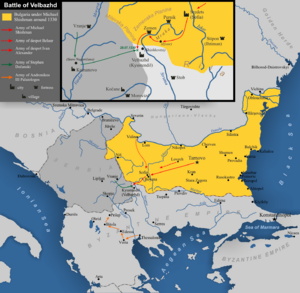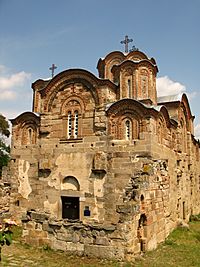Michael Shishman of Bulgaria facts for kids
Quick facts for kids Michael Asen III, "Michael Shishman" |
|
|---|---|

Coin of Michael Shishman
|
|
| Tsar of Bulgaria | |
| Reign | 1323–1330 |
| Predecessor | George II |
| Successor | Ivan Stephan |
| Born | after 1280 |
| Died | 31 July 1330 Velbazhd |
| Burial | Church of St. George, Staro Nagoričane |
| Spouse | Anna Neda Theodora Palaiologina |
| Issue | Ivan Stephan Michael Shishman |
| House | Shishman dynasty |
| Father | Shishman of Vidin |
| Religion | Eastern Orthodoxy |
Michael Asen III (also known as Michael Shishman) was the tsar of Bulgaria from 1323 to 1330. He was born sometime between 1280 and 1292. He started the last ruling family of the Second Bulgarian Empire, called the Shishman dynasty. However, after he became tsar, Michael used the name Asen. This was to show his connection to the Asen dynasty, which was the first family to rule the Second Bulgarian Empire.
Michael Shishman was a strong and ambitious leader. He often made quick decisions in his foreign policy, especially against the Byzantine Empire and the Kingdom of Serbia. His rule ended in a terrible battle called the Battle of Velbazhd, where he lost his life. He was the last Bulgarian ruler in the Middle Ages who tried to make Bulgaria the most powerful country in the Balkans. He also tried to capture Constantinople, a very important city. His son, Ivan Stephen, became tsar after him. Later, his nephew, Ivan Alexander, became ruler and changed Michael Shishman's policy by becoming friends with Serbia.
Contents
How Michael Shishman Became Tsar
Michael Shishman was born between 1280 and 1292. His father was Shishman of Vidin, a powerful local ruler. Michael was also related to earlier Bulgarian emperors. In 1292, his father made peace with the Serbian king, Stefan Milutin. As part of this peace, Michael Shishman got engaged to Milutin's daughter, Anna-Neda. They married in 1298 or 1299.
For many years, the area of Vidin was mostly independent, even though it was part of Bulgaria. Michael Shishman's father and then Michael himself ruled Vidin. They were given the important title of despot. When the Serbian king Stefan Milutin died, Michael Shishman became more involved in Bulgarian politics. In 1323, the young emperor George Terter II died without children. The nobles of Bulgaria then chose Michael Shishman to be their new emperor. Some historians believe he was chosen because he was related to the old Asen dynasty. His half-brother, Belaur, took over as despot of Vidin.
Bulgaria and the Byzantine Empire
War with Byzantium
When Emperor George Terter II died, there was a short time of confusion in Bulgaria. The Byzantine emperor, Andronikos III Palaiologos, took advantage of this. The Byzantines captured many important cities in northeastern Thrace, including Yambol and Sozopol. A Byzantine-supported leader named Voysil also took control of an area near Krăn.
Michael Shishman, the new Bulgarian emperor, quickly marched south to fight Andronikos III. Another Byzantine army was trying to capture Plovdiv, which was defended by Bulgarian soldiers. The Byzantines failed to take Plovdiv. While they were busy there, Michael Shishman took back all the cities in northeastern Thrace. This forced the Byzantines to retreat.
Even though Michael Shishman made Andronikos III retreat, the Byzantines did manage to capture Plovdiv. But Michael Shishman soon drove out Voysil and took back full control of northern and northeastern Thrace. In 1324, the Bulgarian emperor invaded Byzantium again. He went as far as Traianopolis near the Maritsa river. Andronikos III could not fight the Bulgarian army because he had fewer soldiers. He even offered Michael Shishman a duel to end the conflict. Michael Shishman famously replied that only a foolish blacksmith would grab hot iron with his bare hands instead of using tongs. He said he would be laughed at by Bulgarians if he risked himself instead of his army.
The Byzantine emperor was very angry about this answer. Michael Shishman knew that Andronikos III was fighting with his grandfather, Andronikos II. He hinted that he could help Andronikos III if they went to war. Then, Michael Shishman returned to Bulgaria, promising to start talks soon.
Peace and Byzantine Civil War
In 1324, Bulgaria and the Byzantine Empire decided to make peace. Michael Shishman divorced his wife, Anna Neda, and married Theodora Palaiologina. She was the 35-year-old widow of a previous Bulgarian emperor. The reasons for this divorce are not fully clear. Many historians think it was because relations between Bulgaria and Serbia were getting worse. This new marriage helped make peace with the Byzantine Empire. It also gave Michael Shishman an ally against the Serbs. The two countries agreed on their border. Michael Shishman then had peace with his neighbors for several years.
In 1327, Michael Shishman got involved in another civil war in the Byzantine Empire. He supported his brother-in-law, Andronikos III. Meanwhile, Andronikos III's grandfather, Andronikos II, got help from the Serbian king. Andronikos III and Michael Shishman met and agreed to be allies against Serbia. Andronikos III promised Bulgaria land and money if he became the sole emperor.
Andronikos III gained control of Macedonia. But Michael Shishman wanted the Byzantine civil war to last longer. So, he secretly started talking to Andronikos II. He offered military help in exchange for money and some border lands. The Bulgarian ruler sent 3,000 cavalry soldiers to guard Andronikos II in Constantinople. But Michael Shishman's real plan was to capture the old emperor and the city. Andronikos II was warned by his grandson and kept the Bulgarians away from the capital. When Michael Shishman realized his plan was discovered, he sent a secret message to his commander to retreat quickly.
After Andronikos III won the civil war, Michael Shishman tried to take some land by force. He invaded Thrace in June 1328 but retreated when Andronikos III's army advanced. Another meeting near Adrianople ended peacefully. They renewed their peace treaty in October 1328. Michael Shishman returned home after getting a large payment. In return, the Bulgarians gave back the fortress of Bukelon. In 1329, the Bulgarian emperor met with Andronikos III again. They signed a "lasting peace and eternal alliance" and planned to work together against the growing power of Serbia.
Bulgaria and Serbia
Michael Shishman's divorce from Anna Neda in 1324 made relations between Bulgaria and Serbia much worse. Anna Neda had to leave the capital Tarnovo with her sons. She found safety with her brother, Stephen Dečanski, the king of Serbia. At that time, Dečanski was fighting his cousin, so he couldn't directly oppose Michael Shishman.
The two countries were on opposite sides during the Byzantine civil war. Bulgarians were allies with Andronikos III, while Serbs supported his grandfather.
After his agreement with Andronikos III in 1329, Michael Shishman began preparing to attack Serbia. Serbian writers say he proudly demanded that the Serbian king surrender. He even threatened to "set up his throne in the middle of the Serbian land." In 1330, Michael Shishman marched towards Serbia with a large army of 15,000 soldiers. These included troops from his allies in Wallachia and Moldavia. He first went to Vidin, likely to join forces with his brother Belaur's soldiers, and then marched south.
Because of poor communication with the Byzantines, the Bulgarian army met the Serbs alone near Velbazhd (Kyustendil). The Serbian army also had 15,000 men. The two rulers met and agreed to a one-day truce. Both were waiting for more soldiers to arrive. Trusting the agreement, Michael Shishman allowed his army to spread out to find food. However, on the morning of July 28, the main Serbian reinforcements arrived. These included 1,000 heavily armed horsemen. The Serbs broke their promise and attacked the Bulgarians.
Even with the surprise attack, Michael Shishman tried to organize his army. But it was too late, and the Serbs won the battle. This battle changed the balance of power in the Balkans for many years. Bulgaria did not lose land, but Serbia gained control over much of Macedonia.
Death and What He Left Behind
How Michael Shishman died is not completely clear. One Byzantine historian says he was badly wounded in the battle and died soon after. Another says he lived for three more days without waking up and died on the fourth day. Serbian stories say his horse fell during the battle and crushed him. When his body was brought to King Dečanski, the king mourned him but noted that Michael had chosen war over peace. A Bulgarian writer from the 15th century said Michael Shishman was captured and killed by the Serbian king's son, Stephen Dušan. Michael Shishman was buried in the Church of St George in Staro Nagoričane.
Michael Shishman is seen as a strong and energetic ruler. He managed to fix Bulgaria's problems after the confusion before he became emperor. He also kept peace and safety within Bulgaria during his short rule. He is considered one of the most important Bulgarian rulers of the 14th century. He was the last Bulgarian ruler who truly tried to capture the Byzantine capital, Constantinople. He was also the first Bulgarian ruler in many decades to try to be more active in Macedonia. Michael Shishman's image is on the back of the Bulgarian 2 levs banknote, issued in 1999 and 2005.
Family Life
Michael Shishman first married Anna Neda of Serbia, who was the daughter of Stefan Uroš II Milutin of Serbia. They had several children, including Ivan Stefan, who became emperor of Bulgaria after his father. They also had a son named Michael, who briefly ruled Vidin, and another son named Shishman. Michael Shishman's second marriage was to Theodora Palaiologina, Empress of Bulgaria. She was the daughter of Michael IX Palaiologos of Byzantium. They had several children, but their names are not known.
| Family tree of the Shishman Dynasty | |||||||||||||||||||||||||||||||||||||||||||||||||||||||||||||||||||||||||||||||||||||||||||||||||||||||||||||||||||||||||||||||||||||||||||||||||||||||||||||||||||||||||||||||||||||||||||||||||||||||||||||||||||||||||||||||||||||||||||||||||||||||||||||||||||||||||||||||||||||||||||||||||||||||||||||||||||||||||||||||||||||||||||||||||||||||||||||||||||||||||||||||||||||||||||||||||||||||||||||||||||||||||||||||||||||||||||||||||||||||||||||||||||||||||||||||||||||||||||||||||||||||||||||||||||||||||||||||||||||||||||||||||||||||||||||||||||||||||||||||||||||||||||||||||||||||||||||||||||||||||||||||||||||||||||||||||||||||||||||||||||||||||||||||||||||||||||||||||||||||||||||||||||||||||||||||||||||||||||||||||||||||||||||||||||||||||||||||||||||||||||||||||||||||||||||||||||||||||||||||||||||||||||||||||||||||||||||||||||||||||||||||||||||||||||||||||||||||||||||||||||||||||||||||||||||||||||||||||||||||||||||||||||||||||||||||||||||||||||||||||||||||||||||||||||||||||||||||||||||||
|---|---|---|---|---|---|---|---|---|---|---|---|---|---|---|---|---|---|---|---|---|---|---|---|---|---|---|---|---|---|---|---|---|---|---|---|---|---|---|---|---|---|---|---|---|---|---|---|---|---|---|---|---|---|---|---|---|---|---|---|---|---|---|---|---|---|---|---|---|---|---|---|---|---|---|---|---|---|---|---|---|---|---|---|---|---|---|---|---|---|---|---|---|---|---|---|---|---|---|---|---|---|---|---|---|---|---|---|---|---|---|---|---|---|---|---|---|---|---|---|---|---|---|---|---|---|---|---|---|---|---|---|---|---|---|---|---|---|---|---|---|---|---|---|---|---|---|---|---|---|---|---|---|---|---|---|---|---|---|---|---|---|---|---|---|---|---|---|---|---|---|---|---|---|---|---|---|---|---|---|---|---|---|---|---|---|---|---|---|---|---|---|---|---|---|---|---|---|---|---|---|---|---|---|---|---|---|---|---|---|---|---|---|---|---|---|---|---|---|---|---|---|---|---|---|---|---|---|---|---|---|---|---|---|---|---|---|---|---|---|---|---|---|---|---|---|---|---|---|---|---|---|---|---|---|---|---|---|---|---|---|---|---|---|---|---|---|---|---|---|---|---|---|---|---|---|---|---|---|---|---|---|---|---|---|---|---|---|---|---|---|---|---|---|---|---|---|---|---|---|---|---|---|---|---|---|---|---|---|---|---|---|---|---|---|---|---|---|---|---|---|---|---|---|---|---|---|---|---|---|---|---|---|---|---|---|---|---|---|---|---|---|---|---|---|---|---|---|---|---|---|---|---|---|---|---|---|---|---|---|---|---|---|---|---|---|---|---|---|---|---|---|---|---|---|---|---|---|---|---|---|---|---|---|---|---|---|---|---|---|---|---|---|---|---|---|---|---|---|---|---|---|---|---|---|---|---|---|---|---|---|---|---|---|---|---|---|---|---|---|---|---|---|---|---|---|---|---|---|---|---|---|---|---|---|---|---|---|---|---|---|---|---|---|---|---|---|---|---|---|---|---|---|---|---|---|---|---|---|---|---|---|---|---|---|---|---|---|---|---|---|---|---|---|---|---|---|---|---|---|---|---|---|---|---|---|---|---|---|---|---|---|---|---|---|---|---|---|---|---|---|---|---|---|---|---|---|---|---|---|---|---|---|---|---|---|---|---|---|---|---|---|---|---|---|---|---|---|---|---|---|---|---|---|---|---|---|---|---|---|---|---|---|---|---|---|---|---|---|---|---|---|---|---|---|---|---|---|---|---|---|---|---|---|---|---|---|---|---|---|---|---|---|---|---|---|---|---|---|---|---|---|---|---|---|---|---|---|---|---|---|---|---|---|---|---|---|---|---|---|---|---|---|---|---|---|---|---|---|---|---|---|---|---|---|---|---|---|---|---|---|---|---|---|---|---|---|---|---|---|---|---|---|---|---|---|---|---|---|---|---|---|---|---|---|---|---|---|---|---|---|---|---|---|---|---|---|---|---|---|---|---|---|---|---|---|---|---|---|---|---|---|---|---|---|---|---|---|---|---|---|---|---|---|---|---|---|---|---|---|---|---|---|---|---|---|---|---|---|---|---|---|---|---|---|---|---|---|---|---|---|---|---|---|---|---|---|---|---|---|---|---|---|---|---|---|---|---|---|---|---|---|---|---|---|---|---|---|---|---|---|---|---|---|---|---|---|---|---|---|---|---|---|---|---|---|---|---|---|---|---|---|---|---|---|---|---|---|---|---|---|---|---|---|---|---|---|---|---|---|---|---|---|---|---|---|---|---|---|---|---|---|---|---|---|---|---|---|---|---|---|---|---|---|---|---|---|---|---|---|---|---|---|---|---|---|---|---|---|---|---|---|---|---|---|---|---|---|---|---|---|---|---|---|---|---|---|---|---|---|---|---|---|---|---|---|---|---|---|---|---|---|---|---|---|---|---|---|---|---|---|---|---|---|---|---|---|---|---|---|---|---|---|---|---|---|---|---|---|---|---|---|---|---|---|---|---|---|---|---|---|---|---|---|---|---|---|---|---|---|---|---|---|---|---|---|---|---|---|---|---|---|---|---|---|---|---|---|---|---|---|---|---|---|---|---|---|---|---|---|---|---|---|---|---|---|---|---|---|---|---|---|---|---|---|---|---|---|---|---|---|---|---|---|---|---|---|---|---|---|---|---|---|---|---|---|---|---|---|---|---|---|---|---|---|---|---|---|---|---|---|---|---|---|---|---|---|---|---|---|---|---|---|---|---|---|---|---|---|---|
|
|||||||||||||||||||||||||||||||||||||||||||||||||||||||||||||||||||||||||||||||||||||||||||||||||||||||||||||||||||||||||||||||||||||||||||||||||||||||||||||||||||||||||||||||||||||||||||||||||||||||||||||||||||||||||||||||||||||||||||||||||||||||||||||||||||||||||||||||||||||||||||||||||||||||||||||||||||||||||||||||||||||||||||||||||||||||||||||||||||||||||||||||||||||||||||||||||||||||||||||||||||||||||||||||||||||||||||||||||||||||||||||||||||||||||||||||||||||||||||||||||||||||||||||||||||||||||||||||||||||||||||||||||||||||||||||||||||||||||||||||||||||||||||||||||||||||||||||||||||||||||||||||||||||||||||||||||||||||||||||||||||||||||||||||||||||||||||||||||||||||||||||||||||||||||||||||||||||||||||||||||||||||||||||||||||||||||||||||||||||||||||||||||||||||||||||||||||||||||||||||||||||||||||||||||||||||||||||||||||||||||||||||||||||||||||||||||||||||||||||||||||||||||||||||||||||||||||||||||||||||||||||||||||||||||||||||||||||||||||||||||||||||||||||||||||||||||||||||||||||||
Key Dates in Michael Shishman's Life
- 1291 — Michael Shishman gets engaged to Anna Neda of Serbia.
- 1298 or 1299 — He marries Anna Neda.
- By 1308 — He becomes the Despot of Vidin.
- 1323 — He is chosen by the nobles to be Emperor of Bulgaria, using the name Michael Asen.
- 1324 — He wins a war against the Byzantine Empire. He divorces his first wife and marries Theodora Palaiologina.
- 1327 — He gets involved in the Byzantine civil war and signs the Treaty of Chernomen.
- 1329 — He signs a final peace treaty with the Byzantines and an agreement against Serbia.
- July 28, 1330 — The Battle of Velbazhd takes place, where Michael Shishman is badly wounded and dies.
See also
 In Spanish: Miguel Shishman para niños
In Spanish: Miguel Shishman para niños




